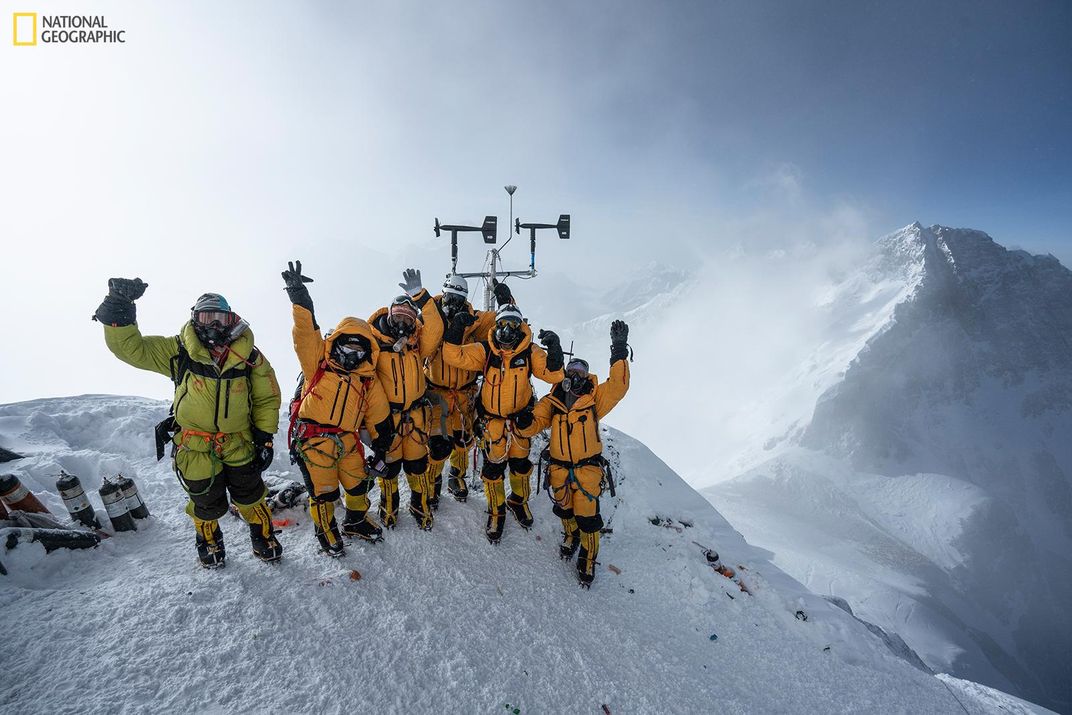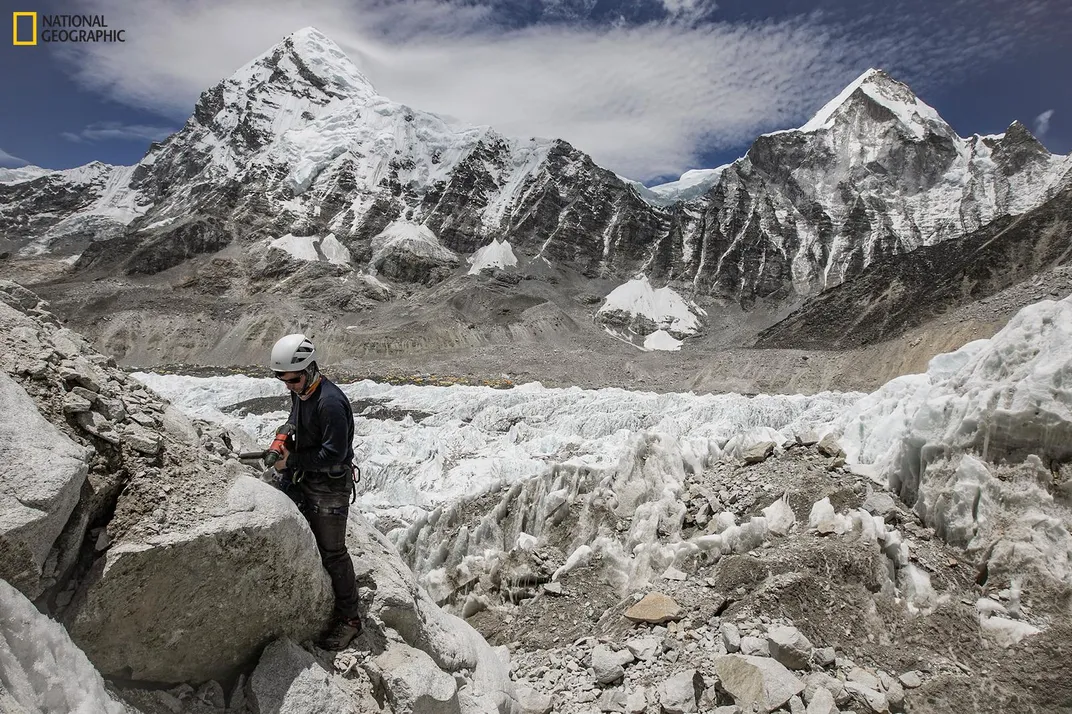Into Thicker Air and Onto Thinner Ice: How Climate Change Is Affecting Mount Everest
Researchers have documented that the high-altitude air is gaining more oxygen and large glaciers are melting at rapid rates
/https://tf-cmsv2-smithsonianmag-media.s3.amazonaws.com/filer/ca/6b/ca6b9b06-bdbe-4269-b11e-9adea2fb2ae4/gettyimages-513452294.jpg)
Despite being the highest point on Earth, Mount Everest still can't escape the effects of climate change. The only place that punctures the stratosphere—Everest's peak reaches 29,035 feet above sea level—has an atmosphere so thin that it leaves mountaineers gasping for breath and glaciers so big that they stretch for miles on end. But both of those elements are changing fast. According to two new studies published today in iScience and One Earth, the air pressure near Everest's summit is rising, making more oxygen available to breathe, and glaciers are melting at unprecedented rates, leading to more meltwater. The changes will impact climbers scaling the peak and local people who live in the shadow of it.
"Some of the lower Himalayan regions are fairly well studied, but a place like Everest is less studied because it's just so hard to do work up there." says Aurora Elmore, a climate scientist at the National Geographic Society. "There's a big gap in the research, especially above 5,000 meters [16, 404 feet]—and Everest is 8,850 meters [29,035 feet]. That huge three kilometers of elevation has been under studied."
To learn more about the highest reaches of the world, last year Elmore helped organize an expedition that sent a team of 34 scientists to Mount Everest to collect glaciological and meteorological data by installing the highest weather stations in the world. The expedition provided the data for both of the new studies, each of which Elmore co-authored.

In a study published in iScience, Elmore and a team of scientists set out to document how the atmospheric pressure on Everest has fluctuated since the 1970s. Each year, around 800 people attempt to summit Mount Everest, but after ascending 21,325 feet, the air gets so thin that most climbers turn to bottled oxygen to help them breathe. Only a handful of mountaineers attempt to climb it without supplemental oxygen. But that may get easier, as climate change is causing the air to slowly thicken, which means more oxygen is available at higher altitudes.
When temperature rises, molecules move faster. And when these molecules start to collide with each other, pressure increases. More pressure means more molecules, making more oxygen available to breathe, says lead author Tom Matthews, a climate scientist at Loughborough University in the U.K.
To analyze the changes in the atmosphere, Matthews and his team collected data using those weather stations they installed on the Everest expedition in 2019. They coupled their newly collected data with analyses produced by the European Centre for Medium Range Weather Forecasting to reconstruct what the climate was like on Everest from 1979 to 2020.
Matthews and his team then used the climate data to model how the atmosphere around Everest has changed over time and how it will continue to change as the planet warms. Their models suggest that if global temperatures increase by 2 degrees Celsius above pre-industrial levels—which the planet is on track to meet as early as 2050—the maximum rate of oxygen consumption on Everest would increase by 5 percent. It may seem like a subtle shift, but that's enough to be the difference between life and death for a mountaineer standing at Everest's peak. "Some people would find [thicker air] as a good consequence of climate change," Matthews says with a laugh. "I think that's stretching it a little bit."
The real surprise of this study, Matthews says, is learning how dramatically the atmospheric pressure on Everest can vary. From the 40 years of data, the team picked out the day with the lowest air pressure on record and compared it to the day with the highest. The difference was huge, Matthews says, with oxygen availability between the two days being equivalent to an elevation change of 2,460 feet.
And the climate can vary remarkably within a span of a few days, he says. On one day, the air at the summit can feel breathable without supplemental oxygen; a few days later, the pressure can plunge to thin, sharp, mid-winter-like air, making it unclimbable. This means that for climbers planning to forego supplemental oxygen and push their bodies to the absolute limits, they must pay close attention to oxygen forecasts. For example, if climbers leave basecamp on a day when an oxygenless summit would be physiologically possible and then arrive a week later when the pressure has bottomed out, it could be a "real horror show," Matthews says.
"What really struck me about this study is that climate change may be impacting the conditions on Mount Everest, and the acceptable conditions on Mount Everest for climbers, in more ways that we have already understood," says Kimberley Miner, a climate risk scientist at the University of Maine who was not involved with this study. "Looking at the way that oxygen is affected in the higher alpine environments [is] something that probably doesn't strike people immediately when you talk about climate change, but these secondary impacts could have very specific effects on climbers and mountaineers [and are] also just as significant."
Although atmospheric changes on Everest aren't visible to the eye, the havoc that climate change is wreaking on glaciers is crystal clear to those living in the region.
"The melting ice in the Himalayas is already alarming," says Pasang Dolma Sherpa, the executive director of the Center for Indigenous Peoples' Research and Development in Kathmandu, Nepal. A few weeks ago, she went hiking in a nearby community, and the local people told her, "Oh, by this time [of year] we used to have already white mountains, but now you see all black." And the floods caused by melting glaciers—which were once rare—are now happening more regularly and unpredictably, she says.
The study published today in One Earth reports just how dramatically glaciers have thinned since the 1960s—in some areas by as much as 490 feet. A team of scientists led by glaciologist Owen King, a research fellow at the University of St Andrews in the U.K., used archived satellite images and old surveys dating back to the 1960s to build a baseline dataset from which to compare future glacier melt. The images came from ten different years spread out between 1962 and 2019.

The team studied 79 glaciers—including the Khumbu Glacier, the highest glacier in the world—and found that between 2009 and 2018, glaciers thinned at nearly twice the rate that they did in the 1960s. And some estimates suggest that a few glaciers have areas on them that have likely lost half of their thickness since the 60s.
The average temperature from 2000 to 2016 is about 1.8 degrees Fahrenheit warmer than the average between 1975 and 2000. Although rising temperatures are the primary drivers of glacier thinning, other big factors are at play, King says. As the glaciers retreat, they often leave behind rocky debris and expose cliffs and troughs on the mountainsides. The exposed rocks absorb more radiation from the sun, melting the adjacent ice. The melted water then seeps into the troughs created by the retreating glaciers, creating small ponds. The ponds melt the surrounding ice, and more water fills the ponds. Ultimately, clusters of ponds join up and form huge glacial lakes. As a result, more than 400 new lakes formed between 1990 and 2015, King says.
Heidi Steltzer, a mountain scientist at Fort Lewis College in Colorado who wasn't involved in the study, says the results are concerning, given the persistent ice loss across the study area.
In addition to the 18 Indigenous communities residing in the Himalayas, nearly two billion people depend on the mountain range for a source of freshwater. As melting accelerates, it puts that once-steady source of water in jeopardy, threatening the lives and livelihoods of nearly a fifth of the world's population.
And although faster melting might mean more water, "it's only a good thing for a little bit of time," Elmore says. If water melts too fast, it arrives in the form of floods, which communities in the region are already experiencing. "They are reaping the repercussions of a global climatic change that they are not major contributors to," she says.
But despite being on the frontlines of climate change, the Indigenous peoples in the Himalayas are often left out of research, climate strategy dialogues and policy making, Sherpa says. "The studies that help people understand the resources they have and the choices [they have] to adapt are just as important as a study of ice loss," Steltzer says. "And maybe that's the next study to come."
/https://tf-cmsv2-smithsonianmag-media.s3.amazonaws.com/accounts/headshot/rasha.png)
/https://tf-cmsv2-smithsonianmag-media.s3.amazonaws.com/accounts/headshot/rasha.png)